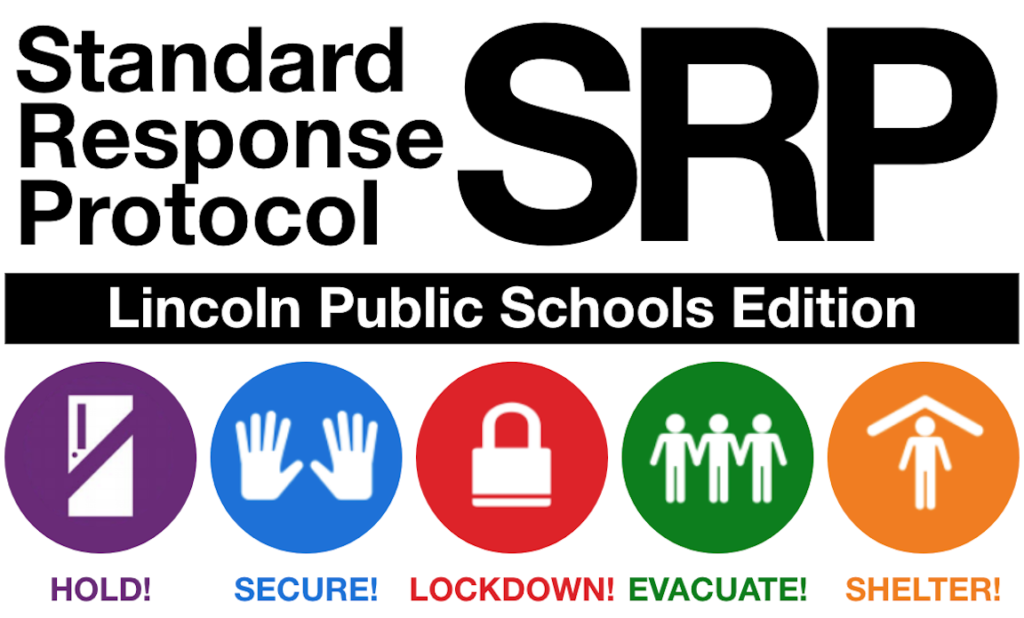Changing the Way We React to Emergencies in the Classroom
The Standard Response Protocol, better known by the acronym SRP, is a brand-new set of guidelines and steps to follow in case of an emergency at school. Starting to be enforced by school administrators across all Miami-Dade County Public School facilities, this new set of safety measures is set to take the place of the already existing “Code Red” and “Code Yellow” protocols starting this month. Ferguson students were introduced to the new protocol last week with a video shown during their first block.
The new emergency response guidelines were established by the foundation “I Love u Guys”. The organization was established after co-founder John-Michael Keyes lost his daughter Emily Keyes as a result of an assault on Platte Canyon High School at Bailey, Colorado in September 2006. With their mission being to “restore and protect the joy of youth”, the association works alongside school districts and law enforcement agencies to establish crisis response and post-crisis reunification programs.
The new protocol allows uniform communication between staff, students, and law enforcement officers. By using clear and concise callouts designed to make sure everyone is on the same page, the new protocol communicates the situation clearly, reducing confusion and steering away from generating panic. “I think it is more calm, and well-checked, because before people would panic a lot, and would get chaotic. Now it is more calm and with no pressure.” Dylan Clark, a sophomore at Ferguson shared with The Talon. Furthermore, school administrators are now able to ensure more effective communication with parents, by providing guidelines on when and how to notify caregivers of potential disruptions during the school day.
The recently introduced sequence also uses standardized language to communicate the circumstances of an emergency. This new use of clear and concise language is easier to understand and raises more awareness of the current situation. “Some schools would use codewords that can cause [students] to be confused. We now have five short codes to remember now. That makes them easier to remember now.” shared Justin Garcia, a current freshman at Ferguson.
The action-based protocol focuses on a directive response to any given situation, each of which prompts a different response from students and staff alike:
Hold
Schools are bound to use this command when a brief altercation occurs in the hallways. It requires students and staff to remain in their classrooms and stay away from exposed areas. Teachers are expected to continue their activities as usual, with no major disruption.
Secure
This notice is to be used to protect students, staff, and visitors within the building when a threat is detected in the vicinity of the school. Comparable to a “Code Yellow” situation, it indicates school security to lock outside doors, ensuring no one can enter, nor exit. In most cases, regular activities can continue with no disruption.
Lockdown
Similar to a “Code Red” event, classrooms turn off their lights and shift students to a safe corner. Lockdowns are to be called when a threat is suspected to be inside the school. The instruction does not require outside doors to be locked, as it can complicate first responder’s entry, alongside protecting staff from being in exposed zones.
Evacuation
An evacuation is called when there is a time-sensitive need to move students and staff to another location. These can be carried out within or outside the school. For example, a mechanical failure such as a power outage can cause school administrators to call for an internal evacuation to plan an early dismissal. On the other hand, an external evacuation is called when situations where it is not safe to stay at school arise.
The foundation has also designed a method to reunify students with their parents in case of an evacuation, denominated “The Standard Reunification Method”. This separate system enables schools to securely unite parents with their children.
Shelter
Primarily targeted to ensure the safety of the community during natural disasters, a Shelter calls cues for actions that must be carried out to ensure minimal damage.
During the launch of these new sets of guidelines, teachers and staff members were provided with resources to learn and prepare to employ the protocol. “They make it really simple for faculty and staff to provide safety measures for students, as well as fellow staff and visitors.” Mr. Rowe, an English teacher at Ferguson commented on the ease of use of the new steps to follow in an emergency. However, many students seem to have disregarded the explanation and lack preparation to employ the new system. Senior Janelle shared her confusion on the matter: “I don’t think it is well understood. I don’t even know what it is. No one really tells you anything”. Students are currently able to see an overview of the procedures thanks to an informative mini-poster positioned inside classrooms.
Students have also thought of potential improvements this program may have. Sophomores Annabella Pazmino and Isabella Martinez expressed their hope to improve communication between teachers and administrators: “The teachers should have walkie-talkies to communicate. That way [administrators] don’t have to announce the all-clear over the PA, and then a shooter knows the situation ended.” Moreover, they also suggested that the faculty should coordinate on a codeword to be used, in case an administrator is held hostage and commanded to give the all-clear for an attacker to use for their advantage.
The new establishment of these safety measures is sure to make a difference in the way students, staff, and parents react to emergencies. Organizing a response policy in collaboration with teachers, staff, law enforcement, and members of the community takes effort and time. Employing an already existing system such as the SRP assists schools in keeping their members safe while using universal language that enables smooth responses from all parties involved. Hopefully, our school community never face the need to use it, and the Standard Response Protocol remains an indispensable tool in keeping everyone safe.
You may be interested
Farewell From the 2024-25 Editor-in-Chief
Kat Torres - May 29, 2025Finding the words to express how I truly feel has been more difficult than I expected. How do you begin to say goodbye…

The Heart and Soul of Our School
Daniella Prieto - May 29, 2025At John A. Ferguson, some of the most meaningful work is happening quietly, all through structure, patience, and consistency. Inside the ASD (Autism…

Chick-fil-A vs. Raising Cane’s: A Clash of Chicken Titans
Kristen Almendral - May 27, 2025There have been debates recently over two fast food chains: Chick-fil-A and Raising Cane’s. Both chains are favorites among many. These fast-food chains…
Most from this category

Exciting Summer Getaway Destinations
Tehreem Chaudhry - May 22, 2025
The Chilly Challenge of the Ferguson Classroom
Leydi Morales - May 20, 2025
















